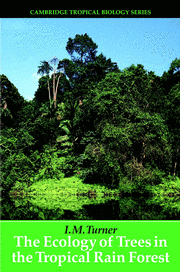Preface
Published online by Cambridge University Press: 24 November 2009
Summary
It is the detail of the . . . tropical forest, in its limitless diversity, that attracts.
F. Kingdon Ward (1921) In Farthest Burma, Seeley, Service & Co. Ltd., London.Trees make a forest: they are both the constructors and the construction. To understand the forest we must know about the trees. This book is about the trees of the tropical rain forest. It was written with the aim of summarising contemporary understanding of the ecology of tropical rain-forest trees, with particular reference to comparative ecology. The analysis of patterns of variation among species is a valuable technique for identifying possibly adaptive trends and evolutionary constraints. It may also provide a means of classifying species in ecological terms. A workable ecological classification might mean that the rain-forest community could be conceptually simplified and made more amenable to analysis.
The organisation of the book follows the life cycle of a tree. The living, growing mature tree is introduced with reference to form and process. Reproduction, including pollination and seed dispersal, follows. Then come consideration of seed germination, seedling establishment and growth, and the completion of the life cycle. At each stage a range of different characteristics and phenomena relevant to tree species growing wild in the tropical rain forest are considered. I have tried to give some idea of what is typical, and what is rare, the range and central tendency exhibited among species, and whether discrete groupings, or a continuous variation, are observed within the forest, and also whether one character tends to be correlated with another.
- Type
- Chapter
- Information
- The Ecology of Trees in the Tropical Rain Forest , pp. xi - xiiPublisher: Cambridge University PressPrint publication year: 2001

